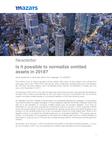
Is it possible to normalize omitted assets in 2018?
This seems to be an absurd question whose answer falls under its own weight, since almost four years ago, when Law 1739 of 2014 was issued, which created the complementary tax normalization tax, the Dian has been stating, and in all possible ways, that the normalization of assets can only occur until December 31, 2017.
The purpose of this column is to raise the legal arguments that have been discussed by the academia recently, which lead to conclude that, by the very nature of the tax normalization tax, this could be used to normalize omitted assets or nonexistent liabilities in 2018 and following years.
As indicated, the Dian initiated a disinformation (or misleading advertising) campaign on the present issue that included one-page messages in Dinero Magazine stating "Remember: Between May 9 and May 22 is the deadline to normalize omitted assets and non-existent liabilities. From then to December 31, you will have a penalty for untimeliness and from January 1, 2018, a penalty of 200% and criminal proceedings" and which ended with the recently issued document called Questions and Answers on the complementary tax of tax normalization where the entity asked itself "What is the deadline I have to normalize the omitted assets and, or nonexistent liabilities? "The answer was as follows: "On December 31 the deadline to normalize the omitted assets and non-existent liabilities is December 31, paying a tax of 13% plus the corresponding penalty for untimeliness and late payment interest.
Remember, as of January 1, 2018, the penalty will be 200% of the determined tax payable (...) If you do not normalize in 2017, you are exposed as of 2018 to administrative and criminal penalties".
These statements, which seemed to be so imperative and categorical, were questioned by the doctrine in several academic events where it was questioned - in light of the constitutional principle of legal certainty - the legal basis for them. Thus, in order to determine whether or not it is possible to benefit from the normalization in 2018 and subsequent years, it is necessary to make a syllogistic test to resolve the following concerns; (i) is the tax normalization tax an amnesty or a tax reorganization? (ii) if it is not... is there a special rule that has modified the way of correcting the tax return or filing it extemporaneously, (iii) if there is no such rule, how can I guarantee that at a certain moment I can make use of the power to correct or file it extemporaneously if the Dian system does not allow me to do so?
The first point to consider is whether or not tax normalization is an amnesty or a tax reorganization. In Ruling C-551/15 (ruling by means of which the Constitutional Court indicated that the tax normalization tax was executory) it was established that "normalization does not depend on the will of the taxpayer, who may or may not avail himself of the provisions of the challenged articles, but it is a real tax obligation, which must be complied with even if he does not have the will to do so".
In this sense, it is clear that the tax normalization, far from being an amnesty or reorganization, is a tax that must be paid by all taxpayers who carry out its generating event.
The second point to be considered is whether there is a special rule that has modified the way to correct the tax return or to file it extemporaneously, which would justify the Dian's position that December 31 is the end of the possibility of accessing this mechanism.
Regarding this point, it is clear that no law has created a special rule restricting the application of penalties for correction or untimely filing of returns (Arts. 641 and 644 of the Tax Statute) in the tax normalization tax, so they are immediately applicable, as they are for any other tax that does not enjoy a special penalty regime.
Finally, as mentioned by a renowned scholar in a recent congress on international taxation, given that in order to comply with the formal obligations the Dian systems must be used, and such entity considers (without any legal reason) that it is not possible to comply with the normalization after December 31, 2017, most likely such entity will disable the electronic mechanisms to correct the tax normalization tax returns or file them extemporaneously.
Therefore, he stated -more seriously than in conversation- that as a "compliance planning" strategy, taxpayers should acquire physical forms in order to at least be able to file such corrections or extemporaneous returns manually, since the Dian would most likely not allow them to do so through its electronic systems.


